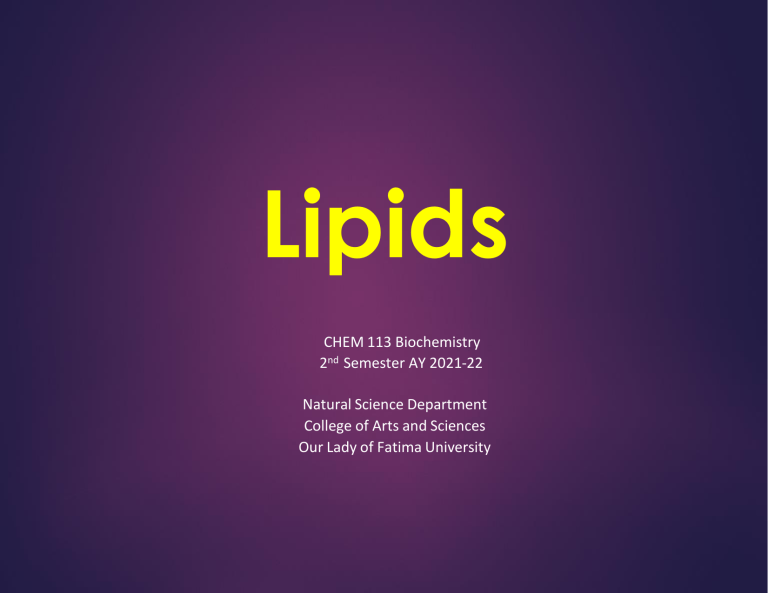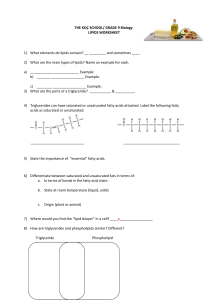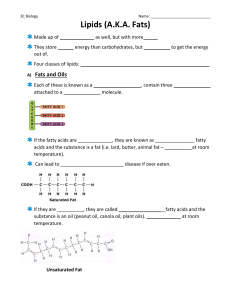Lipids: Biochemistry Presentation for College Students
advertisement

Lipids CHEM 113 Biochemistry 2nd Semester AY 2021-22 Natural Science Department College of Arts and Sciences Our Lady of Fatima University Lipids • Lipids are biological molecules that are insoluble in water but soluble in nonpolar solvents. • Lipids have a wider spectrum of compositions and structures because they are defined in terms of their physical properties (water solubility). • Lipids are the waxy, greasy, or oily compounds found in plants and animals. – wax coating that protects plants – used as energy storage – structural components (cell membranes) – insulation against cold Lipids •Lipids are divided into: 1. Saponifiable lipids - contain esters, which can undergo saponification (hydrolysis under basic conditions) (Examples: (1) Simple; waxes, triglycerides and (2) Complex, phosphoglycerides, sphingolipids) 2. Non-saponifiable lipids - do not contain ester groups, and cannot be saponified (steroids, prostaglandins) •Saponifiable lipids can also be divided into groups: 1. Simple lipids — contain two types of components (a fatty acid and an alcohol) 2. Complex lipids — contain more than two components (fatty acids, an alcohol, and other components) Fatty acids • Fatty acids are long-chain carboxylic acids: Properties of Fatty acids • The long, nonpolar hydrocarbon tails of fatty acids are responsible for most of the fatty or oily characteristics of lipids. • The head, carboxyl (COOH) group is hydrophilic under basic conditions, such as physiological pH (7.4): Micelles • In aqueous solutions, fatty acids associate with each other in spherical clusters called micelles, in which the hydrocarbon tails tangle each other up through dispersion forces, leaving a “shell” of polar carboxylate ions facing outwards, in contact with the water. – Micelles are important in the transport of insoluble lipids in the blood, and in the actions of soaps. Characteristics of Fatty Acids • They are usually have straight chains (no branches) that are about 10 to 20 carbon atoms in length. • They usually have an even number of carbon atoms (counting the carboxyl carbon). • The carbon chains may be saturated (all single bonds) or unsaturated (containing double bonds). Other than the carboxyl group and the double bonds, there are usually no other functional groups. • Shorter fatty acids usually have lower melting points than longer ones (stearic acid [18C] = 700C, palmitic acid [16C] = 630C). • The double bonds are usually in cis configurations: Saturated vs. Unsaturated fatty acid • The cis-double bonds in unsaturated fatty acids put an inflexible “kink” in the carbon chain, preventing the molecules from packing together as tightly as saturated fatty acids do. – For example, stearic acid (saturated), oleic acid (one double bond), and linoleic acid (two double bonds) all have 18 carbons in the chain, but their melting points are drastically different: • Saturated fatty acids lack double bonds between the individual carbon atoms, while in unsaturated fatty acids there is at least one double bond in the fatty acid chain. Saturated fats tend to be solid at room temperature and from animal sources, while unsaturated fats are usually liquid and from plant sources. Essential fatty acids • Most of the fatty acids we need can be synthesized in the body. Two fatty acids, linoleic acid and linolenic acid, both polyunsaturated fatty acids with 18-carbon chains, cannot be synthesized in the body and must be obtained from the diet. These are essential fatty acids. Both are found in plant and fish oils. In the body, they are used to produce hormonelike substances that regulate blood pressure, blood clotting, blood lipid levels, the immune response, and inflammatory reactions. Fats and Oils • Animal fats and vegetable oils are esters composed of three molecules of a fatty acid connected to a glycerol molecule, producing a structure called a triglyceride or a triacylglycerol: Fats and Oils • The fatty acids in a triglyceride molecule are usually not all the same; natural triglycerides are often mixtures of many different triglyceride molecules. • Fats are triglycerides that are solids at room temp. –usually derived from animals –mostly saturated fatty acids •Oils are triglycerides that are liquids at room temp. – usually derived from plants or fish – mostly unsaturated fatty acids Chemical properties of fats and oils • Triglycerides can be broken apart with water and an acid catalyst (hydrolysis), or by digestive enzymes called lipases: Saponification • In saponification reactions, triglycerides react with strong bases (NaOH or KOH) to form the carboxylate salts of the fatty acids, called soaps: Soaps • NaOH produces a “hard” soap, commonly found in bar soaps; KOH produces a “soft” soap, such as those in shaving creams and liquid soaps. • These salts combine two solubility characteristics: –a long, nonpolar, water-insoluble (hydrophobic) hydrocarbon “tail.” –a charged, water-soluble (hydrophilic) “head.” • In water, the “tails” become tangled, leaving the charged heads sticking out into the solution, forming a structure called a micelle. Waxes • Waxes are simple lipids contain a fatty acid joined to a long-chain (12- 32 carbons) alcohol: Waxes • Waxes are insoluble in water, and not as easily hydrolyzed as fats and oils. They often occur in nature as protective coatings on feathers, fur, skin, leaves, and fruits. • Sebum, secreted by the sebaceous glands of the skin, contains waxes that help to keep skin soft and prevent dehydration. • Waxes are used commercially to make cosmetics, candles, ointments, and protective polishes. Phosphoglycerides • Phosphoglycerides are complex lipids that are major components of cell membranes. Phosphoglycerides and related compounds are also called phospholipids. Aminoalcohols in Phosphoglycerides • The most abundant phosphoglycerides contain the alcohols choline, ethanolamine, or serine attached to the phosphate group: Lecithins • Phosphoglycerides that contains the aminoalcohol choline are called lecithins: • The fatty acids at the first and second positions are variable, so there are a number of different possible lecithins. • Commercially, lecithin extracted from soybeans is used as an emulsifying agent in margarine and candies to provide a smooth texture. Cephalins • Phosphoglycerides that contains the aminoalcohols ethanolamine or serine are called cephalins: • Cephalins are found in most cell membranes, and are particularly abundant in brain tissue. They are also found in blood platelets, and play a role in bloodclotting. Sphingolipids • Sphingolipids are complex lipids that contain sphingosine instead of glycerol. Glycolipids • Glycolipids are sphingolipids that contain carbohydrates (usually monosaccharides). They are also referred to as cerebrosides because of their abundance in brain tissue. Biological membranes • Most cell membranes contain about 60% lipids and 40% proteins: –phosphoglycerides (e.g., lecithin and cephalin) –sphingomyelin –cholesterol • The fluid-mosaic model of the cell pictures the cell membrane as being composed of a lipid bilayer, in which the nonpolar tails of lipids point towards the “interior” of the bilayer, leaving the polar, hydrophilic portions pointing outwards. Fluid Mosaic Model • The fluid mosaic model of membrane structure proposes that lipids of the bilayer are in constant motion, gliding from one part of their bilayer to another at high speed Steroids • Steroids are classified as lipids because they are soluble in nonpolar solvents, but they are nonsaponifiable because the components are not held together by ester linkages. • The basic steroid structure contains four fused rings: Cholesterol • Cholesterol is the most abundant steroid in the body. • It is an essential component of cell membranes, and is a precursor for other steroids, such as the bile salts, sex hormones, vitamin D, and the adrenocorticoid hormones. • There is apparently a correlation between high levels of cholesterol in the blood and atherosclerosis. Lipids the end CHEM 113 Biochemistry 2nd Semester AY 2021-22 Natural Science Department College of Arts and Sciences Our Lady of Fatima University





